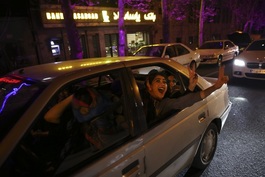 By Samantha Guthrie From April to September 2015, Americans’ belief that Iran poses a very serious threat to the United States rose from 39 percent to 49 percent. In the interim months, Iran dominated headlines, and its rotation in the news cycle has continued into the first months of 2016. Iran’s long isolation from Western markets, rejection of Western political alliances, and exclusion from Westerners’ travel itineraries has built a wall of ignorance around the country. Now that US and EU sanctions have been lifted, a new Iran is emerging onto the world stage, and will be a significant new player on the board, posing a challenge to US foreign policy unlike anything the country has faced in decades. On January 16th, 2016, the International Atomic Energy Agency (IAEA) confirmed that Iran was in compliance with the nuclear deal signed in July by Secretary of State John Kerry and the State Department, after years of painstaking stop-and-go negotiation. While it will take approximately 10 years of continued compliance for all nuclear-related sanctions to be fully rescinded, January’s “Implementation Day” means that Iran will be able to sell its oil on world markets once again, and its banks will be able to connect to the global system. Along with the IAEA’s confirmation of Iranian compliance on the nuclear deal and the subsequent lifting of sanctions, Iran has drawn public attention over the standoff with Saudi Arabia, the capture and release of two naval ships, and, a few days later, five Americans from jail.
These events are interrelated, and they tell a story. They begin to build a narrative on the new Iran; they preview the country’s international future, and foreshadow how the US-Iran relationship will develop over the next decade. Understanding the new Iran will be the key to developing effective, intelligent policy in the Middle East in the context of the new US-Iran relationship. The question now is- what will the new sanction-free Iran look like, and how will the US handle it? The last week of January saw a large Iranian delegation, headed by President Hassan Rouhani, make its way into Europe for the first time in 16 years in search of business deals. After signing $18.5 billion worth of trade deals, the 120-member delegation visited France, where Rouhani inked a $430 million agreement with Peugeot to join with Iranian carmaker Khodro, producing three new models of cars beginning in late 2017. The delegation also finalized a deal with Airbus to update Iran’s commercial air fleet. These deals mark changes in Iran, not only symbolically, but also in ways that will soon be very visible to the average Iranian citizen. Steel and energy in Italy, cars and planes in France- consumer markets are predicted to open along with increased tourism from Europe and America, giving Iranians new opportunities for transparency and dialogue. As standards of living rise, the Iranian people may continue demanding more for themselves and their children, voting in shops and at the ballot box. Iran will held elections for parliament and the Assembly of Experts on February 26. The economic transition does not necessarily herald a political liberalization- in fact, the opposite may be true. Moderate and conciliatory President Rouhani has gained widespread support as a result of the nuclear deal, yet the country’s deeply conservative Guardian Council, which controls elections, has disqualified approximately 5,500 parliamentary candidates. There is strong concern that the Guardian Council will shift elections in favor of conservatives to quell rising public demand for more enfranchisement, participation, and democracy. As Iran is rehabilitated to some degree, it enters an international arena whose institutions and power systems have never had to deal with a participatory, modern Iranian state. Without sanctions, there is no excuse to continue excluding the country- there is even discussion of Iran joining the World Bank. Despite Western attempts to marginalize it, Iran has been a major regional power. Now, the United States may face a new challenge to its self-appointed hegemony- not from Iran directly, but through the destabilizing ripple effects of Iran’s reemergence as a geopolitical giant shaking the foundations of American power in the Middle East. The world will now be forced to listen to Iran’s unique, oppositional voice, and many will inevitably question the status quo- both inside and outside the country’s borders. So, what will the new sanction-free Iran look like? Expect to see international corporations, updated infrastructure and transportation systems, a build-up of the tourist sector…but meaningful political reform is not on the immediate horizon. The American response to the new Iran will be crucial. The results of the November, 2016 presidential election will anticipate the diplomatic and military style of the executive branch for at least the next four years. Republicans have not been shy about their opposition to the Iran deal, while Democrats are more likely to continue foundation laid by the Obama administration. Will Washington need to treat Iran with more respect, taking it more seriously, or will the formal, cautious diplomacy of the years under sanctions fall to the wayside as the relationship become more secure? Whoever takes the political helm next year will be tasked with the creation of a new policy that is consistent with existing Middle Eastern strategy, maintains the country’s competitiveness in international markets, and understands the deep, cultural nuances of the new Iran. Samantha Guthrie is a 2017 MPP candidate at the University of Virginia Frank Batten School of Leadership and Public Policy. She serves as a Staff Writer for the Third Rail blog.
0 Comments
Your comment will be posted after it is approved.
Leave a Reply. |
Categories
All
Archives
April 2022
|
ADDRESSVirginia Policy Review
235 McCormick Rd. Charlottesville, VA 22904 |
|
SOCIAL MEDIA |